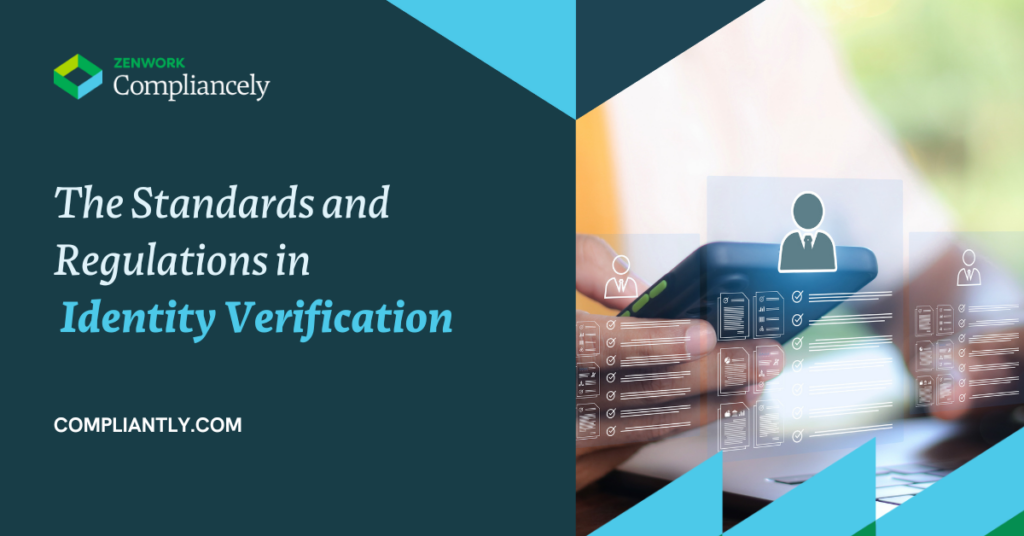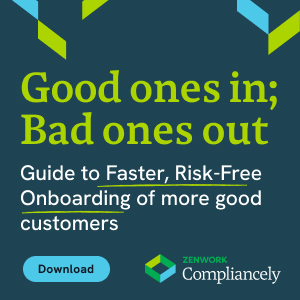The Standards and Regulations in Identity Verification

Identity verification is one of the most sophisticated yet critical tools of the 21st century. Be it customers, employees, contractors, and so on. Identity verification enables you to identify and validate the credibility of your associations.
Not only does identity verification help businesses from a variety of enterprise industries validate the identities of their customers, but it also helps businesses with onboarding verified profiles at a faster rate. This is due to the efficient updates to identity verification and automation thereafter.
You see, verifying someone’s identity is no longer a tedious task, thanks to digitized solutions, but a seamless experience; especially when you automate your identity verification ops with a dynamic infrastructure like Compliancely.
What differentiates identity verification from “background screening” is the sole objective, comprehension, and utility of the derived data.
Identity verification enables you to find leads and insights into a definitive risk factor.
For example, let’s say that you’re recruiting, and you come across a profile that seems legit. But when you verify their identities with real-time identity checks, you come across certain inconsistencies and irregularities, such as involvement in narcotics drug trafficking or embezzlement of funds, which increases the risk quotient of the profile; making them a “high-risk” profile.
Now, digitize this process with a digital infrastructure like Compliancely, and that’s digital identity verification.
The solicitation of identity information, verification of identities, validating the identity information with proof – are all done with a consensus between the customer and the business.
If the customer doesn’t consent to such protocols, a foundational relationship between the business and the customer cannot be established. And this means you cannot proceed further with the customer’s profile.
The standardization of identity verification enables businesses to build an intangible shield of risk prevention, which helps businesses to let go of noncompliant or high-risk profiles.
At the same time, the regulations surrounding identity verification prevent businesses from misusing the authorized data lists.
The following will help you define identity verification, understand the significance of identity verification standards, and how regulations help control the misuse of identity data.
Digital Identity Verification: An Overview
Identity verification is the process of verifying the identities of individuals and entities against authorized data lists as directed and regulated by federal agencies.
Businesses verify the identities after obtaining the identity information and proof of identity from the profiles. These identities are checked against government-authorized data lists in real-time to:
- Ensure the information matches the official records
- Ensure the identities are valid
This allows the business to assess the risk quotient of a profile, screen the profile for other possible leads, and validate the profile for further business procedures.
When you apply the tone of digitization to this practice and use digital tools, online verification systems, and real-time identity verification infrastructure like Compliancely, you’re digitizing the identity verification process.
However, unlike a traditional identity verification process, Compliancely’s digital identity verification enables businesses to verify millions of profiles with great accuracy within seconds.
Now that we have defined digital identity verification, let’s look at its standardization and regulations as follows.
Standardization Of Identity Verification
Standardizing identity verification is nothing but mandating the practice of identity verification for businesses across all industries. The EU, FATF, IRS, and other guardians and regulators of financial operations, endorse the use of identity verification, and more specifically, the use of KYC and AML compliance procedures to combat the risks involved in customer onboarding procedures.
Mandating or standardizing identity verification enables businesses to verify the identities first and then onboard the customers/clients. This creates room for risk assessment and prevents the misuse of the financial ecosystem in a country.
The following are the most common standards of identity verification in use across the globe.
1. KYC/KYB
KYC = Know Your Customer / Client
KYB = Know Your Business
KYC is a standard of identity verification where the identities of the prospects or customers are validated and verified prior to onboarding. The identities + proof of identity is obtained and searched against the most recent, latest data lists.
Entities often verify the TIN (Taxpayer identification number) and legal name of the vendor prior to onboarding the contractor for work. The process of TIN Matching is a good example to understand the mechanism of KYC.
Similarly, banks obtain the social security number, legal name, address, date of birth, and other information to verify the customer’s profile.
2. CIP
CIP = Customer Identification Process
The Customer identification process is a procedure where the identities are validated against the official records of the federal agencies. This allows businesses to not just verify the identities but investigate the profile for any further leads on risk so as to assess the risk quotient of the profile.
Apart from TIN Matching or SSN verification, businesses will screen the profile for any criminal background, adverse media coverage, non-compliance history, and related irregularities.
Customer identification is a primary step that helps businesses establish a foundational relationship with the customer through comprehensive identity verification procedures.
3. Customer Due Diligence
Due diligence is the process where you validate and check the profile for any leads on noncompliance and security lapses. This is a risk assessment practice that enables businesses to check if a profile has been sanctioned or if the profile is under the federal radar.
It enables businesses to prevent onboarding profiles that have had a history of engaging in illegal activities, such as money laundering, terror financing, embezzlement, drug trafficking, illegal arms exports, export of mass destruction material, engaging in restricted trade, and related regimes.
Due diligence is the process of comprehensive scrutiny of a profile to assess the risk quotient and conclude if the profile is compliant with the internal compliance policies, and analyze if onboarding the profile is worth the risk.
The 5th AML Directive suggests that businesses, especially the ones in the BFSI markets, must conduct due diligence and enhanced due diligence procedures as necessary but within reason and feasibility to protect themselves from unnecessary risk avalanches.
4. Risk Monitoring
Risk monitoring is the process of continuing to monitor the risk of onboarded profiles. This enables the financial institutions (banks, financial service firms, and insurance agencies) to check and identify if there is any adverse media coverage on the customer or if the customer’s financial activity seems suspicious.
Cross-border transactions, unknown fund transfers to remote accounts in targeted countries, extreme account activity, transactions with unknown ultimate beneficiary owners, and more are examples of suspicious activity.
Suspicious activity can be observed over a period of time or randomly per the internal compliance policies of the financial institutions. Once the account is involved in such activity, financial institutions have the regulatory authority to freeze the concerned accounts to prevent further risk.
Additionally, a suspicious activity report (SAR) must be submitted by the institution to law enforcement for successive investigations.
Risk monitoring enables financial institutions to let go of noncompliant profiles after the onboarding process, which helps prevent the severity of the risk to a great extent.
Identity Verification: General Regulations
1. AML Directives
The introduction of the Anti Money Laundering Directives (AMLD) has been useful in preventing the risks associated with money laundering and countering global financial crime.
Many illegal organizations, groups, and entities have been relentlessly working to fraudulently gain access to global financial ecosystems, monetary assets, and financial reserves.
The primary goal of AML directives is to counter global financial crime through systemic regulatory compliance practices.
The regulatory directives issued by global financial custodians help businesses establish a foundational relationship with the customers prior to the account opening process, enabling financial institutions to identify, validate, and verify the real identities of the profiles.
2. Data Privacy
While the solicitation of identity information is valid and necessary in the account opening procedures, regulatory bodies around the world endorse the misuse of the obtained information. All organizations must respect the privacy of their customers and must neither transfer the data to third parties nor sell the data to third parties.
Financial institutions must rely on government-authorized identity data lists to verify their identities. This enables consensus of the identity data available and the data lists utilized. This also helps governments to work towards any loose ends in data availability and compliance narratives.
3. Comprehensive Verification Procedures
Global regulatory bodies, such as FATF suggest that businesses need not take extreme steps to meet their identity verification objectives. While the verification process needs to be comprehensive, it is also advised to conduct the due diligence protocols within reason and feasibility.
The catch here is to get accurate results for your checks. This is because the accuracy of your checks plays an intricate role in deciding whether a profile meets your risk threshold.
4. Risk Assessment & Control
This goes without saying. Risk assessment is the sole goal of any identity verification protocol. Global monetary custodians advise businesses to prioritize risk assessment and incorporate risk control practices to prevent onboarding high-risk profiles, prevent the severity of the risk, and detain barriers to compliance.
Risk assessment is a continuous process, where the verification process may begin as a mere KYC protocol, but continues to take different shapes as the customer’s financial activity changes through the years.
A strong compliance policy helps businesses withstand the force of unprecedented risk instances and adapt to change quickly and effectively.
How To Incorporate Digital Identity Verification For Your Business?
Risk is everywhere. It can be sudden and without a strong solution, you could be unprepared, potentially choking your business with possible violations.
But the good news is that you can do something about it.
Compliancely’s real-time identity verification solutions help you prevent risk in real-time, and help you stay compliant, and adapt to change efficiently.
Get Compliancely – a real-time identity verification infrastructure for your business and verify millions of profiles within minutes!
Compliancely is directly connected with the source (federal agencies, such as IRS, SSA, OFAC, etc). This means your identity inquiries are met with real-time accuracy.
Built to protect your business from risk, Compliancely’s dynamic identity verification infrastructure automatically re-screens your data as and when the source data lists are updated, giving your investigations real-time accuracy all the way through.
Explore Compliancely’s API solutions to really leverage the power of unlimited and uninterrupted access to global data lists.
